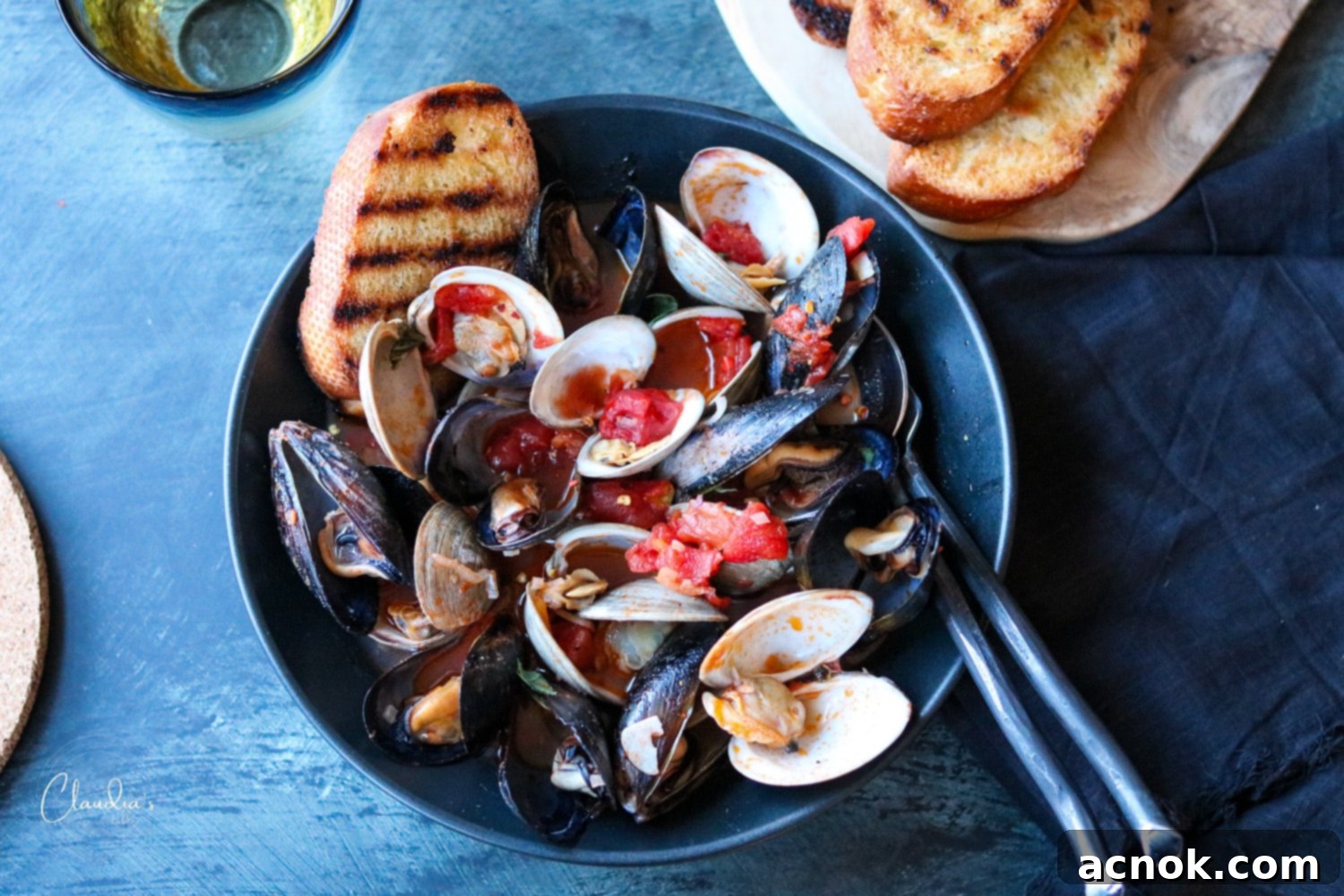Easy Mussels and Clams in Zesty Tomato Wine Broth: A Simple Seafood Recipe
There’s a special kind of magic that happens in the kitchen when you combine fresh seafood with aromatic herbs and a vibrant, savory broth. This Mussels and Clams in Tomato Wine Broth recipe is more than just a meal; it’s a cherished ritual in our home, often enjoyed on leisurely weekends with a glass of crisp white wine and a curated playlist. It’s remarkably quick to prepare, yet sophisticated enough to impress at a dinner party or create an intimate atmosphere for a date night. What makes it so exceptional? The mussels and clams are gently cooked to perfection in a light, fragrant sauce, infused with garlic, shallots, succulent diced tomatoes, a splash of dry white wine, and a touch of butter. The resulting broth is so irresistibly delicious, it practically begs to be soaked up by warm, crusty bread. This versatile recipe is a celebration of fresh shellfish, and for an added layer of texture and visual appeal, you can easily incorporate large shrimp.
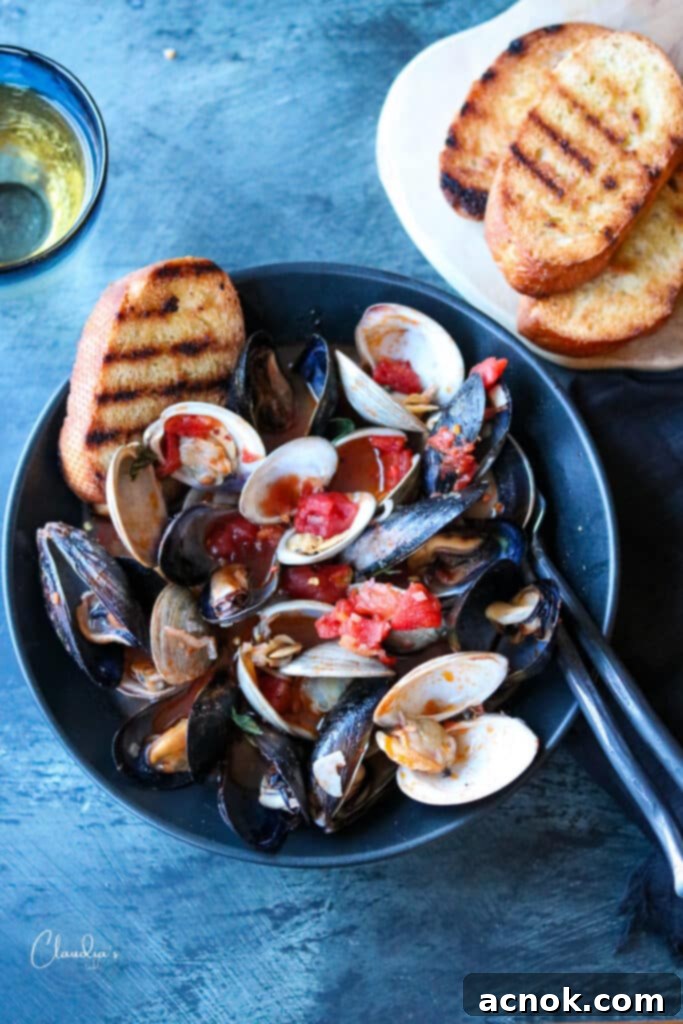
Table of Contents
- Why This Mussels and Clams Recipe Shines
- Nutritional Benefits of Mussels and Clams
- Key Ingredients for this Flavorful Broth
- Choosing & Preparing Fresh Mussels and Clams
- How to Clean Clams
- How to Clean Mussels
- Step-by-Step Cooking Instructions for Mussels and Clams
- How to Toast Sourdough Bread
- Serving Suggestions & Wine Pairings
- Variations and Substitutions
Why This Mussels and Clams Recipe Shines
Shellfish dishes, particularly those featuring mussels and clams, are beloved across various cuisines, often prepared in the vibrant styles of Italian, Spanish, or French cooking. These delightful shellfish combinations truly excel in either a robust tomato-based sauce or a delicate wine butter sauce. While this particular recipe leans towards an Italian flavor profile with its bright tomato notes and white wine base, it’s important to note that my personal all-time favorite shellfish dish remains the classic Moules Marinières, a uniquely French preparation of mussels in a white wine and herb broth. Yet, this rendition of Mussels and Clams in Tomato Wine Broth has firmly secured its place as one of our most adored seafood meals on regular rotation at home.
What sets this recipe apart is its incredible ease of preparation combined with a phenomenal, light flavor profile. The broth is carefully crafted to enhance the natural taste of the shellfish, rather than overpowering it. The original inspiration for this dish came from a Giada DeLaurentiis cookbook, but I’ve made several thoughtful additions and adjustments to the sauce. My goal was to elevate it, making it richer and more substantial, transforming it into a complete, stand-alone dish. Unlike many traditional shellfish recipes that often incorporate pasta, my adaptation ensures the star of the show — the succulent mussels and clams — remain the focal point, while the deeply flavorful broth provides the perfect vehicle for their exquisite taste. It’s a testament to simple, high-quality ingredients coming together to create something truly memorable.
If you’re a passionate admirer of shellfish, don’t miss exploring more of our tempting recipes, which you can find here.
Nutritional Benefits of Mussels and Clams
Beyond their exquisite taste, both mussels and clams are powerhouses of nutrition, making this dish a truly healthy choice. These shellfish varieties are remarkably low in fat, yet boast an impressive amount of high-quality protein and essential Omega-3 fatty acids, which are crucial for heart health and brain function. Furthermore, they are packed with vital micronutrients, including a significant supply of iron, zinc, magnesium, and vitamin B12. Iron is essential for energy and blood health, zinc supports immune function, magnesium is critical for muscle and nerve function, and B12 is vital for nerve tissue health and red blood cell formation.
Given their rich nutrient profile and lean nature, I wholeheartedly consider mussels and clams to be exceptionally healthy. If your aim is to make this recipe even more health-conscious, you can easily omit the butter without compromising the integrity or deliciousness of the broth. The inherent flavors from the wine, tomatoes, garlic, and shallots are robust enough to create a delightful and satisfying broth on their own, offering a lighter yet equally flavorful culinary experience. This flexibility allows you to tailor the dish to your dietary preferences without sacrificing taste.
Key Ingredients for this Flavorful Broth
Crafting this incredible tomato wine broth requires a selection of fresh, high-quality ingredients that harmonize beautifully to create a symphony of flavors. Each component plays a vital role in building the depth and character of the sauce that perfectly complements the delicate shellfish. Here’s what you’ll need:
- 4 tablespoons of good quality extra virgin olive oil
- 6 cloves of garlic, finely chopped, for that essential aromatic base
- 1 shallot, finely chopped, adding a subtle sweetness and depth
- 1 – 28oz can of organic diced tomatoes, forming the heart of our vibrant broth
- 1 cup of dry white wine, like a crisp Sauvignon Blanc, crucial for acidity and flavor complexity
- 1 dry bay leaf, to infuse a delicate, herbaceous note
- Red pepper flakes (optional), for those who enjoy a hint of spicy warmth
- Pinch of Kosher salt (optional, as shellfish are naturally salty)
- 2 tablespoons of unsalted butter, for a touch of richness and silky texture
- 2 pounds of clean, black, or green-tipped Mussels, de-bearded and ready to steam
- 2 pounds of clean, scrubbed Clams, such as Littleneck or Manila, free of grit
- Torn fresh basil leaves, for a fragrant, fresh finish
- Crusty bread (like sourdough) for toasting or grilling, plus extra olive oil to brush on – essential for soaking up every drop of the exquisite broth
Choosing & Preparing Fresh Mussels and Clams
The success of any shellfish dish hinges on the freshness and quality of your ingredients. When you’re shopping for mussels and clams, the absolute best place to find fresh, high-quality shellfish is a reputable fish market. These establishments often have a quicker turnover of seafood and more knowledgeable staff who can guide you. If a dedicated fish market isn’t conveniently located near you, don’t worry – many large grocery stores or specialty grocers will also carry excellent fresh shellfish. Here in Los Angeles, for instance, in addition to dedicated fish markets, stores like Whole Foods and Sprouts consistently offer fresh options.
When you purchase clams and mussels, they should be alive. This means you might observe some of them open, or gently closing when tapped, indicating they are still viable. They should also be kept on ice and appear wet, and most importantly, they should smell fresh – like a clean ocean breeze, never fishy or off-putting. Avoid any shellfish that have cracked or broken shells. I highly recommend buying your shellfish just a few hours before you plan to cook them. Store them in the refrigerator in an open container or mesh bag (never in a sealed plastic bag, as they need to breathe) with some ice until you’re ready to prep and cook. Always follow any specific storage or handling recommendations your fishmonger provides for the particular shellfish you’re buying.
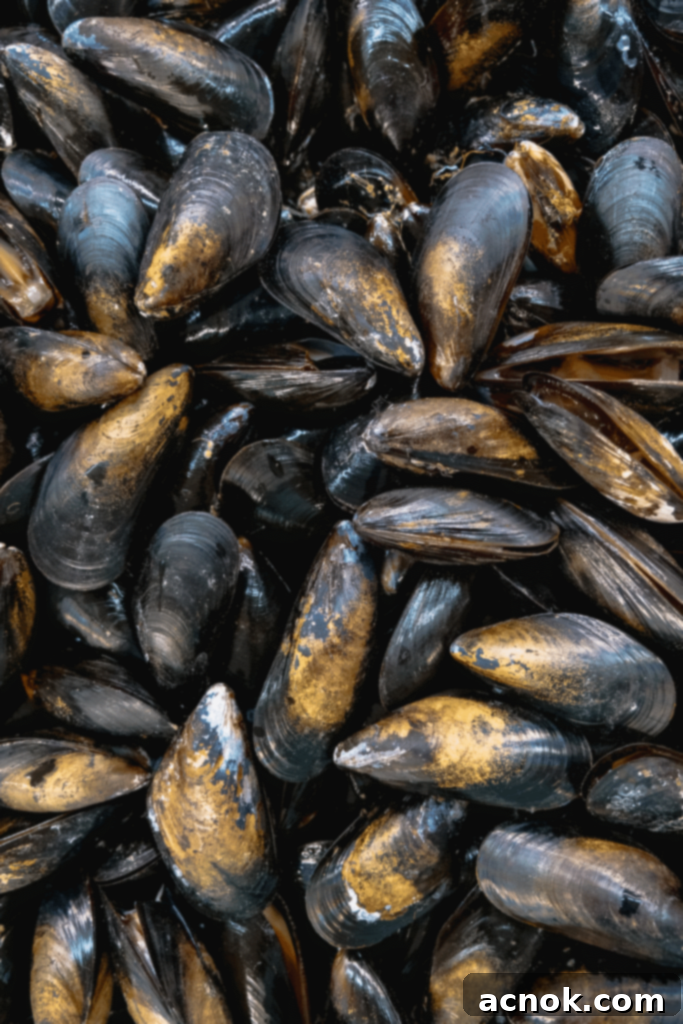
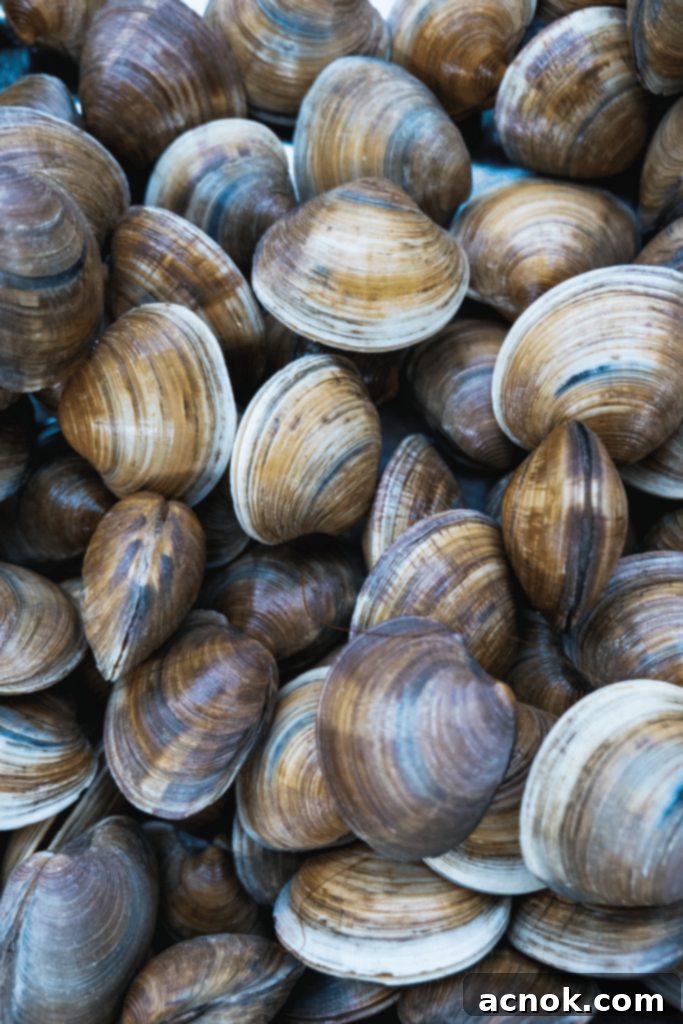
Modern aquaculture practices mean that most shellfish sold today are “purged” before they even reach the fishmonger. This process encourages the shellfish to expel any excess sand or particles from their systems, significantly reducing the amount of cleaning required at home. Typically, what you’ll need to do is give the clam shells a good scrub and rinse, and for mussels, a rinse and de-bearding are usually sufficient. In my experience, the cleaning process is quite minimal these days, so it shouldn’t take much time at all. If you’re new to cooking these types of shellfish, it’s always a great idea to engage with your fishmonger. They can provide specific advice on how clean their current stock is and what level of preparation you’ll need to do.
How to Clean Clams
Once you’re ready to prepare your clams for cooking, transfer them into a large bowl. Under a stream of cold running water, thoroughly scrub the outside of each clam shell to remove any lingering grit, sand, or debris. As you clean them, pay close attention to their condition: discard any clams that are open and do not close firmly when gently tapped. This indicates they are no longer alive and safe to eat. Once cleaned, place the healthy, closed clams in a fresh, clean bowl, and they are now ready to be added to your pot for cooking.
How to Clean Mussels
Mussels, like clams, benefit from a good rinse under cold water to remove any surface dirt. A key step for mussels is “de-bearding.” You’ll often notice a small cluster of fibrous threads protruding from the side of the mussel shell – these are the “beards” which the mussel uses to attach itself to surfaces. To remove them, gently but firmly tug them downwards (towards the hinge of the mussel), rather than pulling them straight out. They should detach quite easily. Keep in mind that most mussels available on the market are farmed, which means they are generally quite clean and have minimal beards. If you happen to source wild mussels, you might find they have more debris and more pronounced beards, requiring a bit more attention. Similar to clams, always discard any mussels that are open and do not close when tapped, as they are not safe for consumption.
Step-by-Step Cooking Instructions for Mussels and Clams
- **Sauté Aromatics:** Using a 5-quart Dutch oven or a heavy-bottomed 5-quart saucier or braising pan, heat the olive oil over medium heat. Add the finely chopped shallots and garlic, and sauté for about 2 minutes, stirring occasionally, until they become fragrant and slightly softened but not browned. This step builds the aromatic foundation of your broth.
- **Build the Broth:** Next, add the diced tomatoes (including their juice), white wine, bay leaf, and red pepper flakes (if you desire a touch of spicy warmth in your broth). Stir in the butter until it melts and incorporates into the sauce. Bring the mixture to a gentle simmer and let it cook for approximately 5 minutes, allowing the flavors to meld and the tomatoes to tenderize and break down slightly. While shellfish are naturally salty, you can add an optional pinch of Kosher salt at this stage if you prefer, but often the natural salinity is enough.
- **Add Clams:** Carefully add the cleaned clams to the pan, arranging them as evenly as possible. Place the lid securely on the pot and allow the clams to steam for 5 minutes. The steam will help them open up and release their delicious liquor into the broth.
- **Add Mussels:** After 5 minutes, add the cleaned mussels to the pot, distributing them over the clams. Replace the lid and continue to cook for another 5 minutes. Both mussels and clams should be fully open once cooked. It is crucial to discard any shellfish that have not opened after this cooking time, as they are not safe to eat.
- **Finish with Basil:** Finally, remove the lid and add the fresh, torn basil leaves. Gently toss the shellfish and broth together to ensure all the mussels and clams are coated in the fragrant, flavorful broth. Serve immediately to enjoy the best taste and texture.
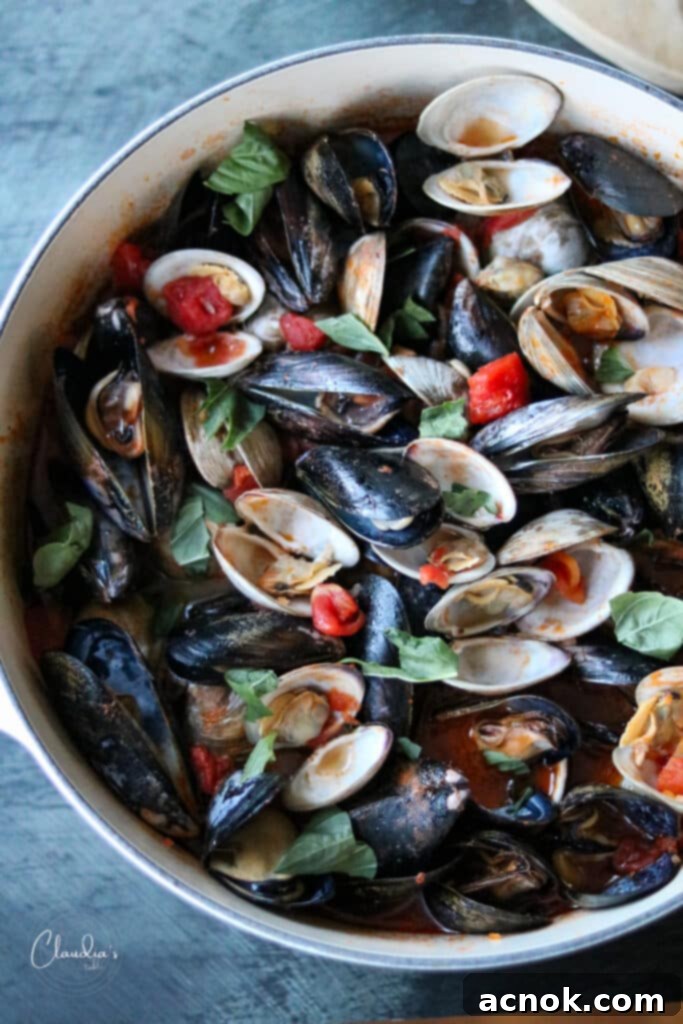
How to Toast Sourdough Bread
No serving of Mussels and Clams in Tomato Wine Broth is complete without perfectly toasted bread to soak up every drop of that incredible sauce. Using a stovetop grill pan, preheat it to medium-high heat. Lightly brush both sides of your sourdough bread slices with olive oil. Place the oiled bread on the hot grill pan and grill each side until it achieves a beautiful golden-brown color and a satisfyingly crisp texture. This method adds a lovely char and enhances the bread’s flavor, making it the ideal accompaniment.
Serving Suggestions & Wine Pairings
To serve this exquisite dish, generously ladle the Mussels and Clams in Tomato Wine Broth into shallow bowls, ensuring each serving includes plenty of that intensely flavorful broth. The crusty, toasted sourdough bread is not just an accompaniment; it’s an essential tool for thoroughly enjoying every last drop of the rich, savory liquid. For a complete meal, consider pairing this dish with a simple, refreshing side salad dressed with a light vinaigrette, or a delicate pasta like linguine tossed lightly with olive oil and fresh parsley to complement the robust flavors without overpowering them.
When it comes to wine pairings, the dry white wine used in the recipe, such as a Sauvignon Blanc, is an excellent choice to drink alongside the meal. Its crisp acidity and citrus notes beautifully cut through the richness of the broth and complement the delicate flavor of the shellfish. Other excellent options include a dry Pinot Grigio, a Vermentino, or a light-bodied Chardonnay (unoaked). If you appreciate the bright, light tomato sauces, you might also enjoy this delicious Ravioli with Burst Tomatoes recipe.
Variations and Substitutions
Absolutely! Shrimp works exceptionally well in this recipe, adding another layer of delicious seafood flavor and texture. To incorporate shrimp, simply reduce the amount of mussels and clams to 1 pound each, then add 1 pound of large shrimp. You can use shrimp that are already peeled and deveined, or opt for shell-on shrimp for a richer broth – the choice is yours. Add the shrimp to the pot simultaneously with the mussels and cook for the same 5 minutes, or until the shrimp turn opaque and pink, and the other shellfish have fully opened.
Yes, you can certainly make this recipe without alcohol if preferred. A good quality vegetable broth or chicken broth makes an excellent substitute for the dry white wine. While the resulting broth might be slightly darker in color compared to one made with white wine, it will still deliver a deeply savory and delicious flavor profile that perfectly complements the shellfish. Ensure you choose a low-sodium broth to control the overall saltiness of the dish.
Yes, absolutely! This recipe is incredibly adaptable. If you have a preference for either clams or mussels, or perhaps only one type is readily available, feel free to use just one. Simply purchase the same total volume of shellfish – 4 pounds in total – using only your preferred type. The cooking times and method will remain the same, ensuring a delicious outcome tailored to your taste.
Yes, absolutely! The beauty of home cooking is customization. If you love fresh herbs, consider adding a sprinkle of fresh parsley or oregano along with the basil at the end for an extra layer of Mediterranean flavor. For those who prefer more heat, don’t hesitate to increase the amount of red pepper flakes to your liking. Conversely, if you’re sensitive to spice, you can reduce or omit the red pepper flakes entirely. Feel free to experiment to find your perfect balance!
If you’ve had the pleasure of trying this exquisite recipe, we would be absolutely delighted to hear your thoughts! Please help other readers discover this fantastic dish by commenting below and sharing your star rating. We 🫶🏼 truly appreciate you!
All content and photographs ©Claudia’s Table and claudiastable.com
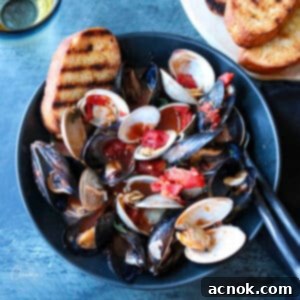
Mussels and Clams in Tomato Wine Broth
Ana | Claudia’s Table
December 20, 2023
Pin Recipe
Equipment
-
1 Dutch oven or heavy bottom pot with lid 7 quart
Ingredients
- 4 tablespoons olive oil extra virgin
- 6 cloves of garlic finely chopped
- 1 whole shallot finely chopped
- 1 – 28 oz can of organic diced tomatoes
- 1 cup of dry white wine like a Sauvignon blanc
- 1 whole dry bay leaf
- red pepper flakes optional
- 2 tablespoons butter unsalted
- 1 pinch salt Kosher
- 2 pounds Mussels, rinsed and de-bearded
- 2 pounds Clams, clean and scrubbed scrubbed Clams
- fresh basil leaves torn
- 8 slices Sourdough bread grilled
- 2-3 tablespoons olive oil
Instructions
How to clean shellfish
-
Once you are ready to prepare the clams, place them in a bowl. Under cold water, scrub any grit off of the shells. Discard any shellfish that are open. Place them in a clean bowl and now they are ready for cooking.
-
For Mussels, sometimes they have some dirt and they need a rinse. However, you will also see a small cluster of what looks like fibers on the side of the mussels. These are the beards. Gently tug down, not out to remove. They should come right off. Again, most Mussels on the market are pretty clean because they are farmed. If you purchase wild Mussels, you will see they have more debris and the beards are noticeable. Like the clams, discard any that are open.
Step by step cooking instructions for Mussels and Clams
-
Using a 7 quart dutch oven or heavy bottom 7 qt saucier or braising pan, heat olive oil over medium heat. Add shallots and garlic and sauté for about 2 minutes.
-
Add diced tomatoes with juice, white wine, bay leaf and red pepper flakes (if you prefer a spicy tomato broth) add butter, stir and allow to simmer for about 5 minutes until tomatoes tenderize and cook down.
-
Add clams evenly in the pan and place lid on the pot. Steam for 5 minutes.
-
Add mussels and cook for 5 minutes more. Mussels and clams will be completely open when cooked. Discard any shellfish that have not opened.
How to grill Sourdough bread
-
Using a stovetop grill pan, preheat to medium-high heat. Brush olive oil onto both sides of Sourdough bread slices. Place on hot grill pan and grill both sides until golden brown and toasted.
How to serve Mussels and Clams in Tomato Wine Broth
-
Place a generous serving of the Mussels and Clams in Tomato broth in a shallow bowl with plenty of broth and grilled bread to soak up the insanely flavorful broth
Notes
Nutrition
Nutritional information is calculated online and should be used as a guide.
All content and photographs ©Claudia’s Table and claudiastable.com
Check out our New & Delicious posts below
- Pasta with Grilled Vegetables, Feta, and Lemon
- Grilled Asian Marinated Flank Steak
- Classic Homemade Chunky Blue Cheese Dressing
- 3-Ingredient Crispy Oven-Roasted Potatoes
- Grilled Peach Avocado Chicken Salad
